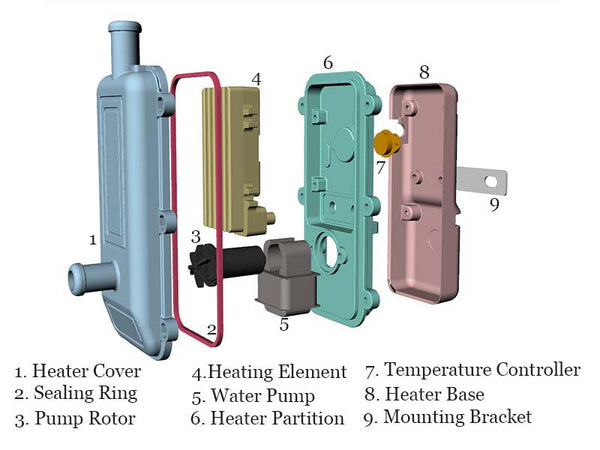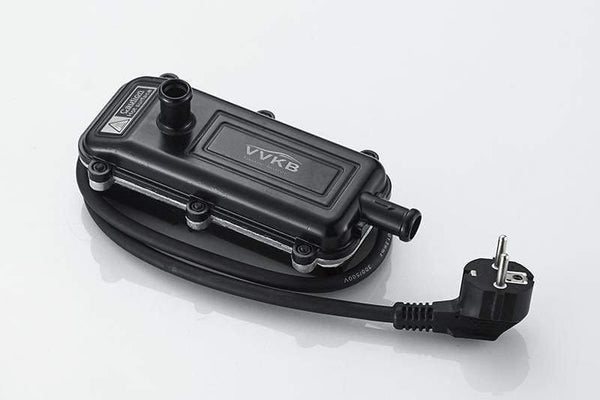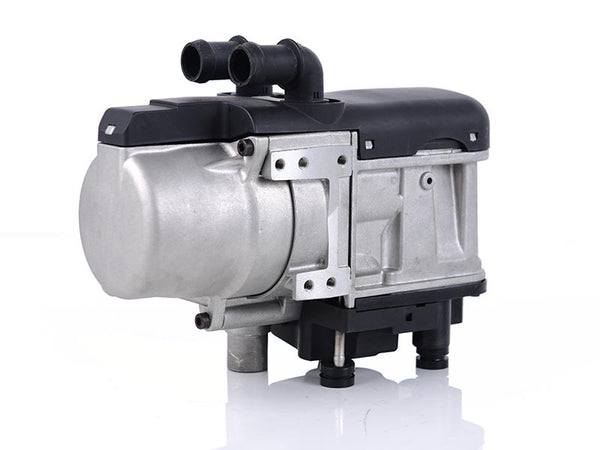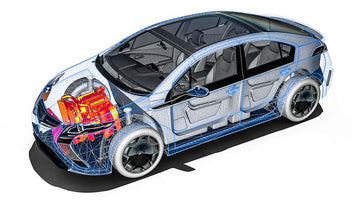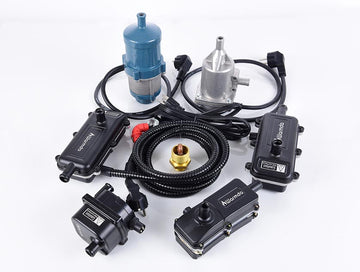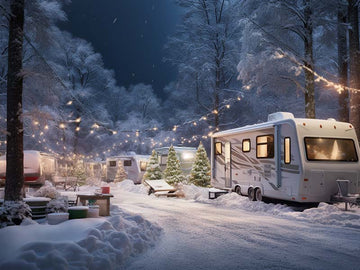The Ultimate Guide to Choosing the Best Engine Heater: Ending the Freeze Start Dilemma
Mar 12, 2024
Introduction
The Challenge of Cold Morning Starts
Picture this: on a chilly winter morning, you make your way across the frost-covered lawn towards your car, a freshly brewed cup of hot coffee in hand, filled with anticipation for the day ahead. However, as you attempt to start the car, you find the engine as if encased in ice, stubbornly refusing to start smoothly. You turn the key, the engine struggles and groans, but fails to kick into life. It's moments like these that remind you of the old saying, "Winter is here, but is your car ready?"
You're not alone in facing the ordeal of getting your car to start on a cold winter morning. It's more than just a minor inconvenience—it's a significant challenge posed by cold weather to car engines. Low temperatures significantly reduce the viscosity of engine oil, increasing wear during start-up and affecting fuel efficiency. For those living in cold regions, this almost becomes a part of daily life during winter.

Breaking the Ice: The Magic of Engine Heaters
Fortunately, there's a solution that can transform this cold morning start ordeal—a highly efficient engine heater. These compact devices can "pre-warm" your car while you're still cozied up in bed, ensuring the engine starts effortlessly by the time you're ready to leave. Whether it's a block heater, an engine coolant heater, or a fuel-operated heater, each type has its unique way of ensuring your engine starts quickly and smoothly on those cold mornings.
By installing the right engine heater, you not only avoid the hassle of cold starts but also prolong the engine's lifespan, enhance fuel efficiency, and most importantly, add an extra layer of warmth and convenience to your winter mornings. Let's dive deeper into how to choose the most suitable engine heater for your vehicle, making this winter stand out.
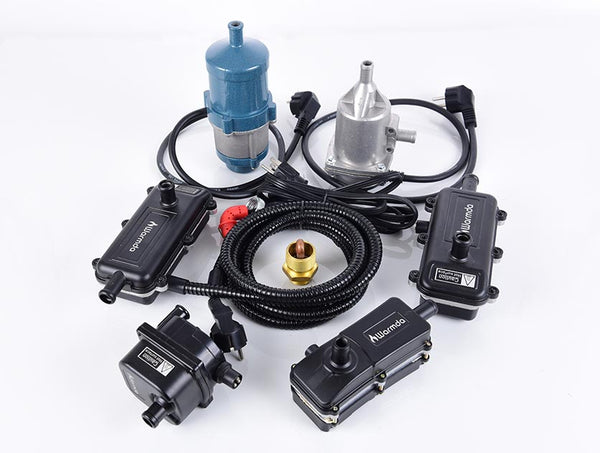
Part One: The Importance of Engine Heaters
Keeping the Engine in Optimal Condition
You've likely experienced the difficulty of starting your vehicle on a cold winter morning. But did you know? Engine heaters play a heroic role not just in making the start-up process easier, but crucially, in maintaining the engine in its optimal working condition.
When temperatures drop below freezing, engine oil becomes thicker, meaning it takes longer for engine parts to get adequately lubricated before starting. This increased friction during the process adds to the engine's wear. Engine heaters, by pre-warming the engine and its oil, ensure that even under extreme cold, the engine parts receive immediate and effective lubrication, reducing wear.

Problems Arising from Not Using a Heater
The consequences of not having an engine heater can be more severe than you might think.
- Accelerated Wear: Starting in cold conditions, due to thickened engine oil, increases internal friction, directly accelerating engine wear.
- Reduced Fuel Efficiency: Cold starts require more fuel, as complete combustion needs a certain temperature. Without pre-warming, more fuel is consumed trying to reach operating temperatures, wasting fuel and increasing emissions.
- Difficulty Starting: Without the help of an engine heater, starting your car on a cold morning can be challenging. This is not just because the engine oil thickens but also because cold temperatures affect battery performance, reducing the power available for the starter, making starting even harder.
Thus, installing an engine heater is not just about comfort or avoiding morning inconveniences; it's a long-term investment in your car's engine health, ensuring optimal performance even in the harshest winter conditions.

Part Two: Different Types of Engine Heaters
Block Heaters
How They Work: Block heaters are installed in the engine block, using a household power supply (110V or 230V) to heat up the engine block and surrounding coolant directly. This method quickly raises the internal temperature of the engine, ensuring the engine oil remains fluid in low temperatures, thus reducing wear during startup.
Ideal Scenarios: For vehicles that often need to start in extremely low temperatures, block heaters are an ideal choice. They are particularly suitable for cars parked outdoors without insulated garages, effectively pre-warming the engine to ease cold starts.
Pros and Cons: The main advantage of block heaters is their high heating efficiency, quickly elevating the engine's temperature and reducing cold start wear. The downside is their direct heating of the block, which may not heat the entire engine as evenly as circulating heaters. If the heating element burns out, replacing the block heater can be quite troublesome.
Engine Block Heaters
Technical Details: Engine coolant heaters operate similarly to block heaters but use a tank-like structure. The heating element is inside this tank, and coolant flows through it to be heated. Engine coolant heaters can more effectively and evenly distribute heat to critical engine parts. Most tank-type engine coolant heaters also come with built-in circulation pumps and temperature controllers, with some even featuring dual temperature controls, ensuring reliable heating without the risk of overheating.
Why They're the First Choice in Cold Regions: Engine coolant heaters are favored in cold regions because they ensure easy, rapid starts even in extreme low temperatures. With built-in pumps and temperature controllers, they precisely control heating, minimizing energy consumption while ensuring the engine reaches optimal working conditions upon start-up.
Fuel-Operated Heaters(Hydronic heaters)
How They Work: Fuel-operated heaters(Hydronic heaters) generate heat by burning fuel to warm the engine's coolant, which is then circulated through the engine by a pump, evenly distributing heat throughout the engine. This method not only raises the engine's temperature but also ensures even temperature distribution, helping to prevent issues caused by local overheating or uneven heating.
Benefits for Engine Performance: The use of fuel-operated heaters (Hydronic heaters) significantly benefits engine performance. First, they can bring the engine to the ideal operating temperature in a very short time, reducing fuel consumption and emissions during cold starts. Second, they generate a substantial amount of heat, capable of warming the entire cooling system. With a fuel-operated heater(Hydronic heaters) installed, you'll quickly enjoy a warm cabin on cold winter mornings.
Understanding these different types of engine heaters, you'll surely find that choosing the right engine heater for your vehicle is an effective way to enhance your winter driving experience and protect your engine. No matter your location's coldness, an engine heater can ensure your engine starts effortlessly.
Part Three: How to Choose the Right Engine Heater for Your Needs
Choosing an engine heater on a cold winter morning is not just a convenience; it's a necessity. But with so many options available, how do you pick the one that best suits your needs? Here are some key considerations.
Assessing Your Needs
First, let's look at how to analyze and determine your needs based on your specific situation.
- Vehicle Type: Different types of vehicles might require different types of heaters. For example, diesel vehicles and gasoline vehicles have different temperature needs during start-up. Heaters also come in various powers; larger engines, like those in big vehicles or generators, need higher-power heaters, whereas smaller engines can opt for less powerful options.
- Parking Environment: Is your vehicle often parked outdoors or in a heated garage? Outdoor parking might necessitate a more powerful heater.
- Frequency of Use: If you live in an area with extreme cold, you might need a more robust and reliable heater to cope with the prolonged low temperatures.
- Heater Voltage: Heaters come in 110V and 230V, as well as 12V/24V options. If your parking location accommodates the use of a power source, choose a heater that matches your local household voltage for a cost-effective option. If access to a power source is inconvenient, consider a 12V or 24V fuel-operated heater, albeit at a higher price.
Detailed Comparison
Next, let's compare several key factors to help you make your choice.
- Performance: The heating speed of the heater is a critical performance indicator. Choose a heater that can quickly warm the engine to the ideal operating temperature.
- Heater Voltage: Based on whether you have access to household voltage, select the appropriate voltage version of the heater.
- Durability: Consider the heater's manufacturing quality and durability. A durable heater can provide reliable service in harsh winter conditions.
- Certifications: Only heaters that meet E-mark, TUV, CE, RoHS, and FCC certifications are considered quality products.
- Ease of Installation: Some heaters might require professional installation, while others are relatively easy to install. Consider the convenience and potential additional costs of installation.
- Energy Efficiency: Look for heaters with high energy efficiency to reduce energy consumption and operating costs.
- Customer Service: With any product, uncertainties can arise during use. A company that offers timely customer service is invaluable.
User Reviews and Ratings
Finally, don't forget to consider feedback from actual users.
- User reviews and ratings are invaluable sources of information on heater performance, reliability, and customer satisfaction.
- Spend time finding and reading these reviews before making a purchase, especially those that match your usage scenarios for direct insights into how a particular model performs under specific conditions.
- However, be aware of the potential for fake reviews on some websites. Seek customer opinions from multiple channels.
By carefully considering these factors, you can choose the engine heater that best suits your car, budget, and needs. Remember, the right heater not only provides convenience during cold winters but also helps protect your engine, extending the lifespan of your vehicle.
Why Choose Vvkb Engine Heaters
With so many different types of engine heaters on the market, what makes Vvkb engine heaters stand out? Here are some advantages of Vvkb engine heaters:
- Long History: Vvkb has 28 years of experience in producing engine heaters and was the designer of the world's first engine heater with a built-in water pump.
- Expert Engineering Team: Vvkb boasts three senior engineers with 28 years of experience, leading a team of more than 10 young engineers. Our engineering team is not short of innovation and experience.
- Wide Range: Vvkb's range includes block heaters, engine heaters with built-in water pumps, and tank-type engine heaters. You can find any type of engine coolant heater you need at Vvkb.
- Customer Service: Any product might encounter issues during use. At Vvkb, any questions or problems you have can be addressed within 8 hours. All you need to do is send us an email.
- Certifications: The quality of Vvkb heaters is certified by authoritative bodies, meeting all standard requirements.
Part Four: Installation and Maintenance Guide
Overview of Installation Steps
While installing an engine heater might seem straightforward, it involves several meticulous steps crucial for ensuring the heater's effectiveness and safety. The basic installation steps include identifying the heater's installation location, preparing the area, installing the heating element, and connecting the power source. Although many heater kits come with comprehensive installation guides, each step must be executed precisely to avoid performance drops or safety risks due to installation errors.
Let's take a closer look at the detailed installation steps for the Vvkb tank-type engine coolant heater:
- Find the Right Installation Location: The heater should be installed at the engine's lowest point, at least 10-20 cm away from fuel lines.
- Drain the Cooling System: Release all antifreeze from the cooling system and collect it in a container.
- Identify the Appropriate Heater Hose: This hose usually connects from the engine to the radiator or cabin auxiliary heater. Cut the hose at the suitable location.
- Attach Hose Clamps to the Heater Hose: Slide the hose clamps onto the heater hose and connect the heater's inlet to the heater hose. Then tighten the hose clamps.
- Refill the Vehicle's Radiator with Coolant: Slowly add coolant to prevent air from being trapped in the heater hose or heater, until coolant starts to overflow from the heater outlet. Keep the heater casing dry to avoid electrical faults.
- Attach the Hose Clamp to the Other Side of the Heater Hose: Connect the hose to the heater outlet and tighten the hose clamp.
- Check the Joints of the Heater and Hose: Ensure there are no coolant leaks. If leaks are found, reconnect the hose.
- Continue Adding Coolant Until the Radiator is Full.
- Do Not Tighten the Radiator Cap: Start the engine and let it run at high intervals to expel excess air.
- Check the Radiator for Coolant Shortages.
- Securely Mount the Heater at the Engine's Lowest Position, Away from Fuel Lines.
- Properly Store the Heater's Power Plug: Ensure the heater's power cord or plug is protected from high temperatures to prevent malfunctions.
The Importance of Professional Installation
Given the complexity of the installation steps, it's highly recommended to entrust the installation of your engine heater to a professional auto repair technician. Professional technicians not only possess the necessary skills and experience but also ensure the installation process follows all safety standards. Moreover, professional installation can prevent potential warranty issues caused by improper installation.
Troubleshooting Heater Failures
Failures in engine heaters typically occur after installation. Most failures result from improper installation. By following our installation guide precisely, your heater should function normally for 5-8 years.
Let's take Vvkb engine heaters as an example to outline some common failures and solutions encountered during use:
-
Failure 1: Intermittent Heater Operation
- Symptoms: The heater pump works intermittently, and the heater casing becomes very hot.
- Causes: Air is trapped inside the heater or heater hose.
- Solutions: Reinstall following our guide to eliminate excess air, and the heater will function normally.
-
Failure 2: Heater Leakage
- Symptoms: Connecting the heater triggers the leakage switch.
- Causes: Two potential causes can trigger the leakage switch. The first is other electrical loads on the same switch, which, when added to the heater's load, exceed the switch's capacity. The second cause is water ingress into the heater's electrical parts, causing leakage.
- Solutions: For the first cause, avoid using many electrical devices simultaneously. For the second, open the heater to dry its interior. If parts are burned, replace them or the entire heater.
-
Failure 3: Heater Not Heating
- Symptoms: The heater pump works normally, the heater's exterior temperature is normal, but the engine is difficult to start.
- Causes: Two reasons can cause this issue. The first, typically with new installations, might be due to extremely low outside temperatures, insufficient heater power, or an old engine requiring more time to heat. The second reason is a burned heating element.
- Solutions: For the first cause, extend the heater's operating time. For the second, replace the heating element.
-
Failure 4: Overheated Heater Casing
- Symptoms: The heater casing is too hot to touch, and the pump does not work properly.
- Causes: The pump impeller is stuck, or the heater pump is damaged, preventing the heated coolant from circulating normally.
- Solutions: Use a small object to rotate the pump impeller. If it still doesn't work, replace the pump.
-
Failure 5: Heater Not Operating
- Symptoms: The heater does not respond when powered.
- Causes: Multiple potential causes include unreliable plug contact, burned thermostat, or completely burned electrical parts.
- Solutions: For the first cause, replace the power connection or ensure a reliable power source. For the second, replace the thermostat. For the third, replace the heater.
These five failures cover all potential issues with Vvkb engine heaters. By following our troubleshooting guide, your heater should return to normal operation.
Maintenance Suggestions
To ensure long-term optimal performance of your engine heater, regular maintenance is essential. Maintenance tasks include:
- Checking Wires and Connections: Regularly inspect the heater's wires and connections to ensure there are no signs of wear, damage, or corrosion.
- Cleaning Heating Elements: Use coolant to clean the heater's interior, removing dirt and preventing reduced heat conduction efficiency and impeller blockage.
- System Testing: Test the heater's performance before the cold season arrives to ensure it operates normally.
By performing these simple maintenance steps, you can extend the lifespan of your heater while maintaining its high efficiency.
Safety Usage Tips
Although engine heaters are effective tools for improving winter car performance, it's crucial to use them correctly and safely. Here are some important safety tips:
- Follow Manufacturer Guidelines: Always operate the heater according to the manufacturer's instructions. Avoid unauthorized repairs or modifications.
- Regular Checks: Regularly inspect the heater and its components for any signs of damage or wear.
- Replace Worn Parts: If any part of the heater shows signs of wear or damage, replace it immediately to prevent potential safety risks.
By following these installation and maintenance guidelines, along with safety tips, you can ensure your engine heater provides optimal performance during the cold winter months while maintaining safety and efficiency. Remember, when it comes to your car and safety, always choose professional services and advice.
Part Five: Additional Tips for Living in Cold Regions
Car Winter Maintenance Suggestions
In the cold winter months, ensuring your car is in peak condition is crucial. Besides installing an engine heater, there are several maintenance and preparation measures you can take to enhance your overall winter driving experience.
- Check the Battery: Cold weather can affect battery performance, making it important to check the battery's condition and charge level before winter.
- Switch to Winter Tires: If you live in an area prone to snow, using winter tires can provide better traction and ensure driving safety.
- Check Antifreeze: Ensuring the antifreeze is below the proper freezing point can prevent the engine cooling system from freezing in extremely low temperatures.
- Keep the Fuel Tank At Least Half Full: This prevents fuel lines from freezing and ensures you have enough fuel to seek help in emergencies.
Combining Engine Heaters with Other Car Accessories
To minimize the impact of winter on your car, wisely combining an engine heater with other car accessories like antifreeze is a smart move.
- Using with Antifreeze: Ensure your antifreeze is suitable for the lowest temperatures in your region. The engine heater pre-warms the engine, while antifreeze protects the cooling system from freezing, offering dual protection.
- Using Low-Temperature Oil: In cold temperatures, oil can freeze. Ensure you use oil suitable for low temperatures to prevent engine freezing.
- Using Thermal Car Covers: If you don't have a garage, using a thermal car cover can reduce the impact of cold weather on your car, making the engine heater's job more efficient.
- Regular Checks and Adjustments: While using these accessories, regular checks and adjustments are also crucial. Ensuring all equipment is in good condition provides the best protection and performance during winter.
By following these additional maintenance and preparation measures, you can ensure your car maintains optimal performance in the cold winter months and enhance your driving experience. Whether using an engine heater or other car accessories, the key is to prepare and maintain ahead of time to ensure safe, comfortable driving in cold weather.

Conclusion
As winter approaches, the cold mornings remind us once again of the importance of ensuring our cars can start smoothly in extreme conditions, not just for our comfort but for the health of our beloved vehicles. Engine coolant heaters play an indispensable role in this regard, significantly enhancing car performance in cold regions and greatly increasing user comfort. Whether it's block heaters, engine coolant heaters, or circulating heaters, each type has its unique advantages, designed to meet the specific needs of different cars and users.
Making an Informed Choice
We encourage every reader to consider their specific needs—are you often faced with the challenge of cold starts? Is your vehicle exposed to extreme low temperatures? Based on these considerations, make an informed choice. Selecting the most suitable engine heater type not only ensures warm starts during cold winters but also prolongs the life of your car and improves fuel efficiency.





